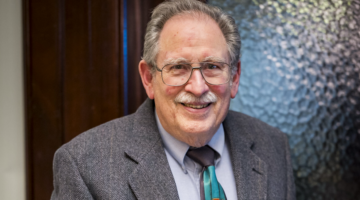Ed. note: This is the latest installment of The ATL Interrogatories, brought to you by Lateral Link. This recurring feature will give notable law firm partners an opportunity to share insights and experiences about the legal profession and careers in law, as well as about their firms and themselves.
Jeffrey E. Stone is Co-Chair of McDermott Will & Emery LLP and Chair of the Firm’s Management Committee. In addition to his management roles, Jeffrey is a nationally recognized trial lawyer and a Fellow of the American College of Trial Lawyers. He concentrates his practice in the areas of white-collar criminal defense, complex commercial litigation, internal investigations and RICO. He represents corporations, boards of directors, senior executives and other individuals in a variety of complex civil litigation and criminal prosecutions, involving a broad range of industries, including health care, manufacturing and financial services. He has tried more than 40 cases to verdict before juries in federal and state court.
Jeffrey has served as National Chairman of the Stanford Fund (responsible for all annual giving to Stanford University), as a National Trustee for the Lawyers’ Committee for Civil Rights Under Law, as outside counsel to the Illinois Judicial Inquiry Board, as a board member of the Jewish Federation of Metropolitan Chicago, and as president of the Jewish Family and Community Services agency. He currently serves as a member of the national Board of Governors for the American Jewish Committee.

8 Tips For Creating A Comprehensive ‘AI In The Workplace’ Policy
Corporate investment and usage in generative AI technologies continues to accelerate. This article offers eight specific tips to consider when creating an AI usage policy.
1. What is the greatest challenge to the legal industry over the next 5 years?
I think that the greatest challenge that the legal industry faces stems from the converging pressures from clients for lower costs and higher quality. The traditional model — in which lawyers charged for their time as measured by the number of hours worked — is going to go away, but there is no compelling alternative out there yet that has been fully embraced by corporate clients and law firms. Figuring out how to set prices, in a way that captures the true value rendered by lawyers, is likely to be the greatest challenge to the legal industry over the next five years. But for the firms that figure this out, it also represents a tremendous opportunity to align interests between clients and firms — and that is going to be very powerful.
2. What has been the biggest positive change to the legal profession since the start of your career?

A Career In Legal Services: Practising Law Institute Honors Toby J. Rothschild
PLI honors Toby J. Rothschild with its inaugural Victor J. Rubino Award for Excellence in Pro Bono Training, recognizing his dedication and impact.
The greatest positive change has been the use of new technology. For me, as a trial lawyer, the ability to amass and assess vast quantities of evidence and data and then directly access it in real-time without going through intermediaries, coupled with the ability to display that evidence in compelling new ways before a jury, is tremendously exciting. When I started trying cases in the 1980s, all of our graphics had to be drawn by hand; if we needed to change something the night before it was to be presented, the graphic artist literally had to re-draw the exhibit or use “white out” to make the change. Today, with the use of the technology in the courtroom, it is an entirely different game – we can make real-time adjustments in the courtroom, and we have all sorts of new ways to tell our stories to juries. As a result, the way we argue to juries and present our case is completely different from what it was 25 years ago.
Parallel to the technological changes has been an equally significant change in the staffing model. When I started practicing law in the early 1980’s, most law firms had a rigid line of delineation between associates and partners, and there were virtually no other categories. Today, we employ a much more nimble staffing model. At McDermott, we have different skill/price points to meet our clients’ needs: we have staff attorneys and project attorneys to work on e-discovery matters; we have patent attorneys and patent agents to work on patent prosecutions; we have abolished mandatory retirement so that we are not arbitrarily driving out talented senior lawyers; we have part-time partners to accommodate family and parenting challenges; and we seek a much more racially, geographically and gender-diverse work force, so that we get the benefits of different ways of thinking and solving problems.
3. What has been the biggest negative change to the legal profession since the start of your career?
The biggest negative change has been the increasing financial and time pressures that have squeezed a lot of the traditional mentoring moments out of the profession. As a young lawyer, I learned a tremendous amount just by watching older lawyers try cases and by listening to them swap stories about the cases they had tried. As a young assistant U.S. attorney, I was given the freedom to watch some real giants in the courtroom, and no one ever told me that I was wasting my time or that I should be doing something else. While we will always learn best by doing, we also learn very efficiently by watching real masters at work. I worry that those opportunities are fewer and farther between.
4. What is the greatest satisfaction of practicing law?
Without a doubt, the greatest satisfaction in practicing law is making a difference for a client – either by winning a case at trial or, sometimes even better, giving them the advice and representation that allows them to avoid a bad result. Knowing that you have made a difference in someone’s life, perhaps in a way that changes the rest of their life, is one of the greatest parts of this profession.
5. What is the greatest frustration of practicing law?
Dealing with people who confuse obstinacy for advocacy.
6. What is your firm’s greatest strength?
I think it is a combination of really deep substantive expertise coupled with a relentless commitment to serving and advising our clients. We believe that quality is more important than quantity, though, so we do not seek to be all things to all clients. We aim to be truly great in our core practice areas, and not try to do everything for every client. In fact, we teach our lawyers that it is not only appropriate, but actually smart and honest to tell a client that something is not our strength, and that we will help them find the best-in-class attorneys for that issue. Any client that hears that message knows that this is a law firm that is looking out for the best interests of the client, and that is a very powerful message.
7. What is the single most important personal characteristic for a successful lawyer in your field?
Personal integrity.
8. What is your favorite legally themed film or television show?
A Few Good Men (affiliate link). The final scene in the courtroom when Nicholson cracks under cross is the classic example of taking the witness where he really wants to go, and doing it with drama, style and persuasive power. While it seems effortless in the movie, it really captures that magical moment when all the preparation and strategy comes together. While Hollywood moments like this may be few and far between in real courtrooms, they are truly incredible when they do happen.
9. What is your favorite legally themed book (fiction or non-fiction)?
Almost anything by Scott Turow – he really understands the challenges of building a case and he captures the mood of a courtroom better than anyone.
10. What would you have been if you weren’t a lawyer?
A fireman.
Lateral Link’s recruiters are on pace to place hundreds of attorneys throughout the world this year. We are currently involved in over three dozen active partner searches including opening the office of an Am Law 50 firm in a new location, the merger of an Am Law 10 firm with a foreign firm, finding practice chairs for several Am Law10 firms, and searches for groups of partners in at least ten different cities, including Atlanta, Silicon Valley, Los Angeles, New York, Shanghai, Hong Kong, Dallas, Denver, and Chicago, just to name a few. We are currently working with partner candidates with $500k to $35M in portable business. For more information, please call Michael Allen, Managing Principal at Lateral Link.